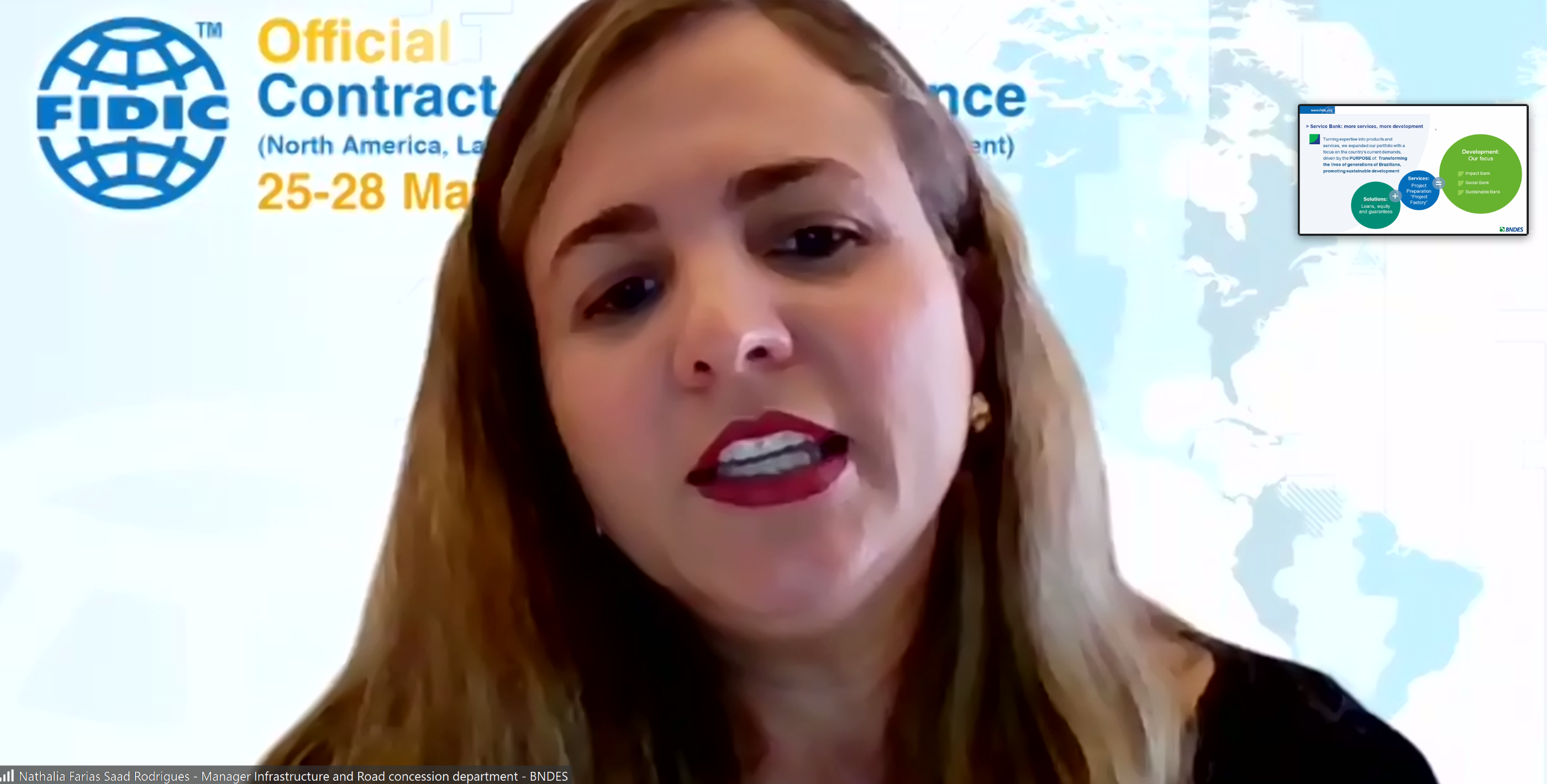Day three of the Official FIDIC Contract Users’ Conference (North America, Latin America and Caribbean time zone event) on 27 May 2021 was a ‘regional day’ focusing on the LATAM and Mexico regions, with keynote speakers and case studies drawn from across the region, writes FIDIC communications advisor Andy Walker.
Introducing the third day of the event, sponsored by FIDIC global strategic partner, international law firm CMS and regional day sponsor, law firm NPG Abogados, FIDIC past president Dr Jorge Díaz Padilla said that Latin American countries were not familiar with “model contracts” and that FIDIC was perceived as an organisation specialising in European affairs. There was therefore a challenge to promote the adoption of FIDIC forms in the industry across the region. Things were improving though, said Padilla, with the signing of recent agreements by FIDIC with the World Bank and Inter-American Development Bank, which he was confident would lead to even greater usage of the contracts going forward.
The first speaker in session one was Henrique de Aragao, president of FIDIC’s Latin American regional group, FEPAC, who spoke about some of the key aspects for successful projects and the challenges facing the consulting engineering sector in the region. He highlighted the social, economic and political effects of the Covid pandemic on the region and the challenges faced by the construction sector.
The infrastructure needs were acute in the region, said de Aragao. Current investments in infrastructure in the region have a 2.5% deficit and the required investments to modernise and universalise access to minimum standards would need to be at 4% of GDP over the next two decades. “Future investments in consulting engineering are expected to be between $5.1bn and $11.5bn yearly,” de Aragao said, highlighting the scale of the investment challenge. He said that currently the main obstacles to increased investment in infrastructure projects were the lack of a long-term infrastructure plan, the politicisation of infrastructure project priorities and the ongoing lack of stability in public policies.
Following a brief country-by-country assessment of the situation facing the industry in the main countries in the region, de Aragao turned his attention to the bidding process for infrastructure projects. “Bids need to be based on quality and in this way, it will mean that consulting companies will have to organise themselves with the best competence to be successful on bids,” he said. Warning against cut-throat bidding, he said: “If bids are based on the lowest price the tendency will be that engineering companies hire professionals and services of lower quality, reducing the quality and value of investments. Hiring should not be by lowest design or construction price!”
A number of the emerging trends and developments affecting the industry in the region were highlighted by de Aragao, including globalisation, smart cities, digital transformation and decarbonisation and environmental issues, which he said had been made event more urgent by the Covid pandemic. As well as being key challenges for the industry, these issues should be seen as opportunities for consulting firms in the region, he said.
The potential was there for the sector to take a lead. “The degree of development of knowledge and technologies will have to be able to reactivate the global economy and at the same time seek a reduction of social inequalities faced by the world. We believe that the new professional training of the consultancy sector will allow us to act in this way – as indispensable activity in the construction of a desirable world,” said de Aragao.
The next speaker was Jaime Gray, founding partner of law firm NPG Abogados based in Lima, Peru. Speaking about the construction industry and FIDIC forms in the LATAM region, Gray said that despite LATAM having had no tradition of employing model contracts, with historically bespoke contracts being used in the region, some “sophisticated employers had decided to use the FIDIC forms as in some specific cases these forms were used as part of a reasonable agreement between parties”. The use of FIDIC contracts had also been boosted by multilateral agencies promoting the use of the FIDIC forms and such projects benefited from the recognised good international construction contract practices that FIDIC contracts bring to the table, said Gray.
Gray then highlighted further the benefits of using FIDIC forms, which he said were many and included being able to use model forms which bring a balanced risk allocation, being able to manage the project through the use of sensible contractual tools, have an active engineer in the cases of the Red and Yellow Books as well as establishing a direct relationship between employer and contractor in the case of the Silver Book and also, importantly, facilitating the resolving of claims and disputes in the most effective manner through determinations by engineers and decisions by dispute boards.
Kicking of the second session of the conference, Julio Cesar Bueno, partner at Pinheiro Neto Advogados, spoke about the adoption of FIDIC forms in the LATAM region. “The importance of having an international approach to what we do locally is that we can benefit from the FIDIC contracts and the advantages that they bring,” said Bueno. He also looked at some of the issues that had limited the use of FIDIC contracts in Latin America. The idea that “things have always been this way, and if it is not broken, you don´t need to fix it” was prevalent in the region and this had led to a lack of will to evolve towards better contracting, he said.
Speaking next was Nathalia Farias Saad Rodrigues (pictured above), manager of the infrastructure and road concession department at the Brazilian Development Bank (BNDES). She spoke about the work of the bank in funding infrastructure in Brazil and said that the priority of BNDES had always been development, financing major projects across many sectors including power generation, telecoms, highways, railways, sanitation, airports and ports. “In the last 20 years 1,908 infrastructure projects worth $177bn have been funded by the BNDES,” she said, while explaining that the bank had also been expanding its operations to provide “privatisation and concession preparation services with 121 project mandates worth $43bn to date”.
She said that the bank was preparing a large infrastructure project portfolio over the coming years which was continuously growing. BNDES was working towards sharing risk with more players (and not just banks), structuring and taking part in co-financing operations and boosting the number of players in the Brazilian financial market. “We are aiming to foster innovative risk sharing schemes that both reduce project costs and mitigate the use of sponsors’ balance sheets,” said Rodrigues.
Alex Wagemann, lawyer and founding partner at Wagemann Lawyers & Engineers, gave the contractor’s perspective from the region and highlighted some of the pros and cons of adopting FIDIC contracts. Wagemann concluded that the FIDIC Pink Book was “a very well-balanced contract compared with any public legal framework in the region” and that FIDIC requires a process of adaptation in some provisions, to harmonise it with civil law principles, particularly administrative law. He saw the main challenge as being related to the acknowledgement that “FIDIC is a contract with a different risk balance compared with a normal public-work contract and the application of administrative procedures should be reconsidered”. Wagemann also made it clear that there was an urgent need for additional training for Latin American stakeholders to foster a better understanding of the FIDIC principles.
The final session of day three looked at the Spanish and Portuguese translations of FIDIC contracts and the benefits of using them. Pablo Laorden, founder and managing partner at Lámbal Abogado, highlighted the need for native language translations of contracts as a basic step to avoid misunderstandings and controversies on projects. “Given that many contract controversies relate to the ‘specific’ meaning of one word or expression, or to the interpretation of a sentence or paragraph or of a local law or permit, why should we be discussing about each stakeholder’s translation or interpretation when we can have the original contract in our own language?” said Laorden.
He made the point that a common language and/or understanding of the contract documents and all communications during the project is key for the success of the project. “The main benefit of using the FIDIC forms in the local language is that it facilitates its understanding by all stakeholders, minimising misunderstandings, claims and disputes, thereby contributing to the success of the project,” Laorden said.
Julio Cesar Bueno, partner at Pinheiro Neto Advogados, then outlined the history of legal and contractual systems in Brazil and Latin America and the development of construction contract models. He highlighted some of the challenges facing the adoption of standard contract forms, including the risk of a clash with local laws, the risk of the contract not being understood or accepted by the courts or arbitrators and also the risk that the parties are not able to adequately manage or adapt themselves to the requirements of FIDIC forms. Bueno thought that the influence of World Bank, the Brazilian Development Bank and also foreign investors towards the adoption of FIDIC forms would mean that there would be a move towards greater adoption of FIDIC contracts in the years to come.
Finally, Leonardo Toledo da Silva, partner at Toledo Marchetti Advogados, highlighted two case studies from Brazil. He talked about the Mário Covas Ring Road, North Section ("Rodoanel Norte”) and Line 4 of the São Paulo Metro (“Metrô Linha 4 - Fase 2”). Both case studies highlighted projects where there had been challenges and disputes and the roles played by the dispute avoidance adjudication boards. Da Silva acknowledged that “there is still an important job to be done in the strengthening of DABs and DRBs in Brazil” and that this was an ongoing process. The issues raised in these two case studies are complex and best understood by watching this part of the conference again on the FIDIC website.
Summing up day three of the conference, FIDIC CEO Dr Nelson Ogunshakin thanked all the speakers for delivering an excellent event and said it was great to see representation at the event from influential organisations like the Brazilian Development Bank. "If the banks believe that FIDIC contracts are the way to go then the industry must follow and take note," he said. Ogunskain highlighted the paramount importance of projects being delivered on time, on programme and on budget and "the best way of ensuring that was to use FIDIC contracts - in the native language of the local region!" he said.
FIDIC would like to thank global strategic partner, international law firm CMS and regional day sponsor, law firm NPG Abogados for their kind support for this event.







